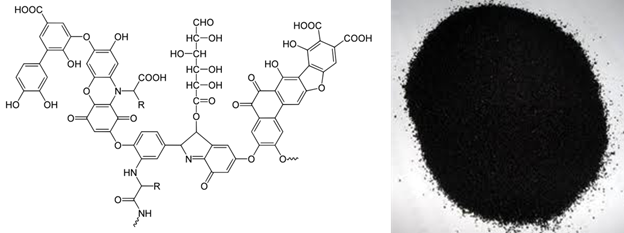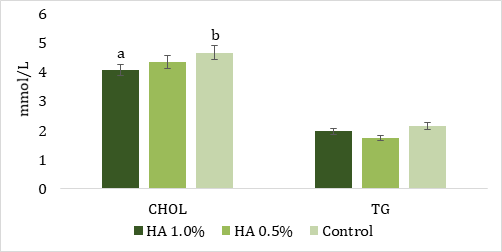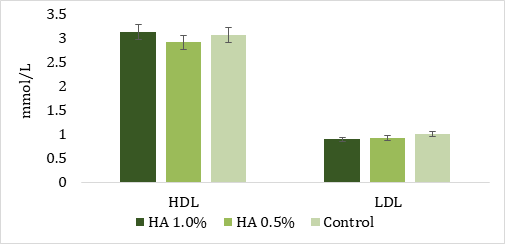International Journal of
eISSN: 2574-9862


Research Article Volume 5 Issue 2
1Department of Nutrition and Animal Husbandry, University of Veterinary Medicine and Pharmacy, Slovakia
2Department of Public Veterinary Medicine and Animal Welfare, University of Veterinary Medicine and Pharmacy, Slovakia
Correspondence: František Zigo, University of Veterinary Medicine and Pharmacy, Department of Nutrition and Animal Husbandry, Košice, Komenského 73, 040 01, Slovakia, Tel +421-908-689-722
Received: October 08, 2020 | Published: November 16, 2020
Citation: Zigo F, Vargová M, Lakti?ová KV, et al. Effect of humic acid as an organic additive on growth performance, carcass traits and selected blood parameters of Japanese quails. Int J Avian & Wildlife Biol. 2020;5(2):27-30. DOI: 10.15406/ijawb.2020.05.00170
The supplementation of different organic sources to diet have become an inherent practice in poultry production to improve the growth and quality of meat. Therefore evaluation of the effects of humic acids (HA) on the final body weight, carcass traits and the changes in selected blood parameters of Japanese quails was the major concern in this study. A total of 72 one day old unsexed Japanese quail chicks from line Pharaoh fed a commercial diet were randomly divided into one control and two experimental groups (n=24) with two replications (12 and 12 per pen), and fattened for 52 days. The dietary treatments consisted of the basal or control diet without supplementation and the diet supplemented with 0.5% and 1.0% of humic acids (HA1 group at 5g•kg-1 and HA2 group at 10g•kg-1) from the 1st day finally to 52 days of fattening in HA1 and HA2 group, respectively. The results showed that quails weight and carcass yields of breast and thigh meat after 52 days of fattening did not show any alterations between monitored groups. The 1% addition of HA had a positive impact on the reduction of blood cholesterol level, which can contribute to the use of HA in the feed for the production of quality meat with low-fat content.
Keywords: Japanese quails, humic acids, diet, carcass yield, fattening, cholesterol
The poultry industry is one of the largest animal agriculture sectors on the world. This industry continues to evolve with the addition of new bird species, such as the Japanese quail (Coturnix japonica), to complement the existing species such as broiler chickens, turkeys, ducks and geese. Japanese quails are a promising species with excellent meat quality traits, high edible meat yield from breast and thighs and optimum meat composition from dietetic point of view.1 Report by Dobrzański et al.2 showed that quail meat and eggs are renowned for their high quality protein, high biological value and low caloric content, making it a choice product for hypertension prone individuals (Table 1).
Component |
Japanese quail |
Broiler chicken |
Proteins / 100g of meat (g) |
19.6 |
18.6 |
Total cholesterol / 100g of meat (g) |
12.1 |
15.1 |
Saturated fats (g) |
3.4 |
4.3 |
Monounsaturated fats (g) |
4.2 |
6.2 |
Omega 3 fatty acids (mg) |
460 |
190 |
Omega 6 fatty acids (mg) |
2300 |
2880 |
Cholesterol (mg) |
76 |
75 |
These birds are mainly produced for their meat and eggs but are also used as laboratory animals because of their small size and require little cage space for rearing. The preference for the breeding of Japanese quail is justified by the fact that it is well adapted to commercial cage farming and possesses several advantages, such as rapid growth, early sexual maturity, easy handling of adult size, and a short generation interval.4
In recent years, the addition of different organic dietary sources have become an inherent practice in poultry production. Not only as they represent a source of energy but also the beneficial content of improving the growth and quality of meat. Humic acids (HA) are one of the possible natural compounds used in agriculture due to their positive effect and nutritional benefits for domestic animals. Humic substances (HS) are geological deposits made of a complex mixture of acids which arise from the natural decomposition of plant and animal material by soil microorganisms occurring in water, soil, carbon and other sources. Humates include humus, humic acid, fulvic acid, ulmic acid, and trace minerals. They are soluble in alkaline media, partially soluble in water, and insoluble in acidic media (Figure 1).5,6

Figure 1 Structure and color of humic acid.
Source: De Melo et al.7
Due to their amphiphilic character, HAs form micelle-like structures in neutral to acidic conditions, which are useful in agriculture, pollution remediation, medicine and pharmaceuticals.6
Moreover, many positive effects on the performance and health of animals have been attributed to HA. Some studies investigated the effect of using HA as growth promoter in poultry and obtained positive results. It could enhance the bird immunity and reduce various kinds of stress.8,9
In broilers, Mudroňová et al.10 found that HA improved the ileal digestibility of energy and the retention of nutrient. Moreover, HA can act as an antibacterial agent and could reduce mold growth and consequently reduces the toxin level.
The present study was designed to compare the influence of HA added to diet as a 0.5% and 1.0% concentrate on the final body weight, carcass yield of the breast and thigh muscle and the changes in selected blood parameters of Japanese quails.
All procedures involving animals followed the guidelines stated in the Guide for the Care and Use of Animals (protocol number 3323/16-221/3) which was approved by the State Veterinary and Food Administration of the Slovak Republic.
Experimental groups selection and supplementation
This study was conducted using 72 one-day-old Pharaoh Japanese quails purchased from a commercial supplier (Farm Mala Ida s.r.o., Slovak Republic). The chicks were randomly divided into 3 groups: one control (C) and two experimental groups (HA1 at 5g•kg-1 and HA2 at 10g•kg-1), 24 pieces per group (2 replicates of 12 birds in each). The chicks were kept in pens with wood shavings and straw in agreement with technological instructions for Japanese quails11 regarding light regimen, temperature, animal hygiene and feeding. The birds were fed commercial starter and finisher diets (from day 1 to 21 and from 22 to 52, respectively). The access to water and feed was ad libitum during 52 days of fattening. The experimental group diets were supplemented with natural HA (HUMAC® Natur AFM; Humac s.r.o., SR) of the 65% content of free HA in dry matter at the amount 0.5% and 1.0% (at 5g•kg-1 and 10g•kg-1) to the commercial feed mixture.
Slaughter procedures and biochemical analyses
Slaughter and biochemical analysis was performed from 12 randomly selected Pharaoh Japanese quails of each group. On day 52 of the fattening, the animals were weighed, stunned, killed by cervical dislocation and bled. The carcasses were plucked, eviscerated and weighed according to Jaďuttová et al.12 The carcass yield was determined as a proportion of the body weight before slaughter and after evisceration. The yields of breast meat (without bones) and thighs (with bones) were calculated as a proportion of meat weight and carcass weight (Figure 2). The results were expressed as a percentage of the body parts to the entire carcass.
Blood samples were collected from vena jugularis from 12 birds in each group on the last day of fattening, using disposable sterile syringes. The blood was then transferred to sterilized centrifuge tubes. Total cholesterol and triglyceride levels were determined from blood serum by a method described by Hammad et al.4 Concentration of HDL-cholesterol was determined according to Sugiuchi et al.13 Concentration of LDL-cholesterol was determined by a method according to Bachorik14
Statistical analysis
The obtained data were evaluated using GraphPad Prism 3.0 and expressed as mean ± standard deviation (X±SD). Individual results between groups were statistically compared with one-way ANOVA test. Tukey comparison test was used to compare the differences between the values of the all monitored groups and P<0.05 was considered a significant difference.
There are many studies focused on the effect of the addition of HS to the feed during the fattening period, but the results are controversial. Some researchers reported a significant effect on the broilers’ live weight, weight gain, carcass yield and feed conversion ratio.15,16 In contrast, other studies noted only non-significant effects on the above-mentioned parameters during the fattening period.17,18
Thus, the objective of this study was to observe the effect of feeding with 0.5% and 1.0% addition of the HA to quails feed. Table 2 show quails weight and carcass yiel d during the 52 days’ supplementation period by administration at 5g•kg-1 and 10g•kg-1 HA to diet. The carcass yield in Pharaoh Japanese quails was 67.3% with variations between 66.7 and 68.2% of the live weight. These values are similar than other published percentages - from 65% tо 69.5%.19,20
Item |
Unit |
HA1 |
HA2 |
Control |
M±SD |
M±SD |
M±SD |
||
Total BW (after 52 days) |
g |
279.4±16.1 |
265.9±19.3 |
271.7±21.5 |
BW after evisceration |
g |
187.2±15.7 |
180.6±13.5 |
181.3±12.6 |
Carcass yield |
% |
68.2±3.8 |
67.1±4.4 |
66.7±4.1 |
Breast meat yield1 |
% |
38.4±1.8 |
37.1±2.6 |
36.2±2.2 |
Thighs meat yield2 |
% |
23.1±2.5 |
21.4±2.1 |
22.8±2.7 |
Table 2 Effect of dietary supplementation of humic acids on body weight and slaughter parameters of quails
Control, control group of Japanese quails fed with commercial feed; HA1, experimental group of Japanese quails fed with 0.5% addition of humic acids; HA2, experimental group of Japanese quails fed with 1% addition of humic acids to commercial feed; BW, body weight; Breast1 and thighs2 yield - the yields of breast meat (with bones) and thighs (with bones) were calculated as a proportion of meat weight and carcass weight. The results were expressed as a percentage of the body parts to the entire carcass, n=12.
Comparison of body weight after 52 days of fattening did not show any alterations between monitored groups. Also, the results showed that they were not observed statistically significant differences in the slaughter parameters and carcass yield of quails between the control and supplemented groups. The carcass yields of breast and thigh meat after 52 days of fattening were slightly higher in the group supplemented with HA at concentration 5g•kg-1, but the differences were not significant (P>0.05).
Similar results were reported by Karaoglu et al.15 which supplemented broilers with different doses of humic acids. Author reported that HA supplementation to diets of broilers at doses of 0.1, 0.2 and 0.3 % had no effect on the carcass yield of broilers chickens. Ozturk et al.17 found improved body weight gains and feed efficiency without affecting the feed intake of broiler chicken when HA was added to the drinking water at a dose of 300ppm. In same study, the high humic acid-treated chickens (450ppm) showed a reduction in body weight.
Slightly reduced body weight (P>0.05) in the group of quails fed a diet supplemented with HA at concentration 1.0% could be caused by increased fat metabolism. As a result of increased fat metabolism, were observed lower blood cholesterol levels in HA1 group compared to the control. Apart from lowered cholesterol, the effect on the level of triglicerides was not confirmed between the control and supplemented groups (Graph 1).

Graph 1 The effect of adding humic acids to diet on the levels of cholesterol and triglicerides. Control, control group of Japanese quails fed with commercial feed; H 1.0%, experimental group of Japanese quails fed with 1% addition of humic acids to commercial feed; H 0.5%, experimental group of Japanese quails fed with 0.5% addition of humic acids; CHOL, cholesterol; TG, triglicerides. Results are presented as mean (M) ± SD from 12 quails of each group; a,b – values above the columns sharing different letters are significantly different (P<0.05).
The similar results were recorded by the Jaďuttová et al.12 who confirmed lower serum cholesterol levels (P˂0.05) in broilers fed with 0.8% and 1.0% addition of humic substances. On the other hand, the author did not record significant changes in the levels of high density lipoproteins (HDL) and low density lipoproteins (LDL) of both experimental groups compared to control. As in the previous study, no changes of HDL and LDL cholesterol levels were observed from our results by comparing the supplemented groups with the control group (Graph 2).

Graph 2 The effect of adding humic substances to diet on the levels of HDL and LDL cholesterol. Control, control group of Japanese quails fed with commercial feed; H 1.0%, experimental group of Japanese quails fed with 1% addition of humic acids to commercial feed; H 0.5%, experimental group of Japanese quails fed with 0.5% addition of humic acids; HDL, high density lipoproteins; LDL, low density lipoproteins; Results are presented as mean (M) ± SD from 12 quails of each group.
According to several authors, beneficial effect of feeding with added HS is a decrease in the blood plasma cholesterol concentrations.9,21 Bahodari et al.22 also observed decreased concentrations of cholesterol after feeding broiler chickens a diet containing HS. These results are in agreement with our findings, as we recorded a decrease in blood cholesterol in experimental group of quails fed a diet supplemented with HA at concentration 1.0%.
Significantly lower concentrations of cholesterol in serum of chicken fed a diet supplemented with humate (Farmagülatör DRYTM) at concentrations 0.25 and 0.125% on day 35 of trial were found by El-Husseiny et al.23
Genchev et al.24 indicates that the fat content of 5 to 7 weeks-old Pharoh Japanese quails is very low (>1.3% of live weight). Selection of the appropriate line quail fed with 1% addition of HA can be an effective tool to reduce fat content to a minimum of live weight quails making carcasses very attractive from dietetic point of view.
In conclusion, we can state that feeding with HA (0.5% and 1.0%) did not manifest an improvement in the final body weight and slaughter parameters of quails. There was a significant effect on the reduction of blood cholesterol level in the group of quails fed with 1% addition of HA, which can contribute to the use of HA for the production of quality meat with low fat content.
This work was supported by the Slovak project KEGA no. 006UVLF-4-2020 ‘Implementation of new scientific knowledge in teaching and improving the practical training of students in breeding technology from subject Animal husbandry’.
Authors declare that there are no conflicts of interest.
None.

©2020 Zigo, et al. This is an open access article distributed under the terms of the, which permits unrestricted use, distribution, and build upon your work non-commercially.